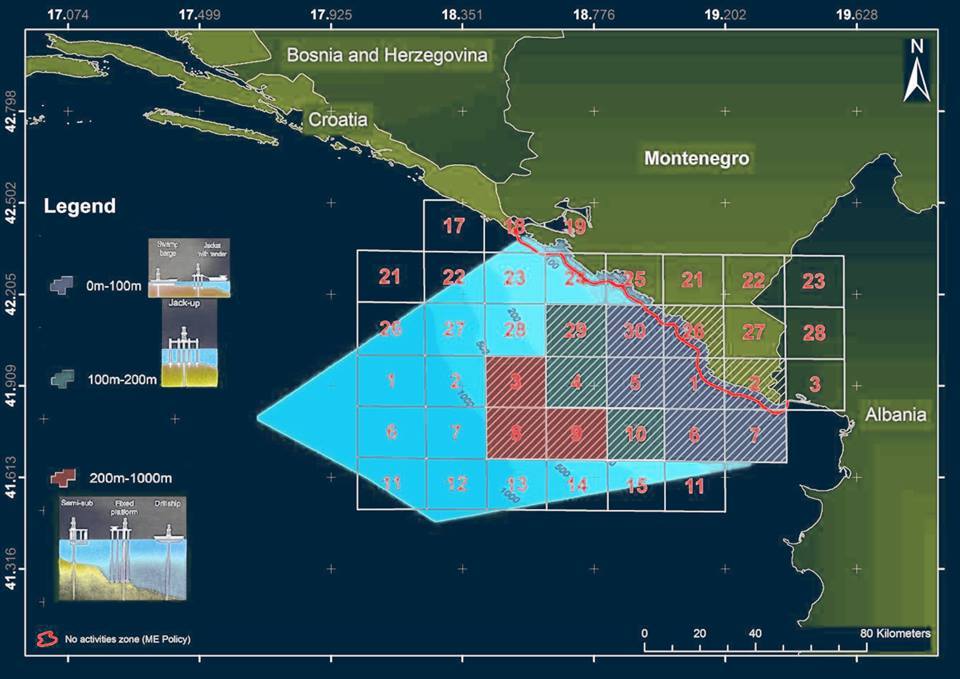TO:
Ministero dell'Ambiente e della Tutela del Territorio e del Mare, Italia via Email - dva@minambiente.it
Ljiljana Maksimović (via Email - info@mek.gov.me) Ministry of Economy Rimski trg 46 81000 Podgorica, Montenegro
RE:
Public Consultation for the Draft Report of the Strategic Environmental Impact Assessment for the Program of Exploration and Production of Hydrocarbons Offshore Montenegro
Dear Mrs. Maksimović,
We take this opportunity to submit our comments which ultimately urge Montenegro to halt all offshore hydrocarbon drilling programs in the Adriatic Sea.
It is incomprehensible, particularly after the conclusion of the Paris climate conference where 195 countries throughout the world agreed to keep hydrocarbons in the ground to avoid irreversible climate change, cut emissions, restore and protect communities, and especially protect our oceans, that Montenegro’s drilling plans continue to go forward. Although that moment was a more formal event stamping the end of the fossil fuel era, the mountain of evidence from decades of ecosystem and community destruction should be enough to provide you with an informed decision to remove these plans. That being said, now include the readily viable options in clean energy that are outperforming fossil fuels in development, job creation, and revenue and the risk to the Montenegrin coast, its tourism and fishing sectors, its people, and the entire Adriatic should not even be under consideration.
Not only would one moderately sized accident permanently damage the entire ecosystem, but the cumulative effect of the expected expansion of multiple wells creates a long-term pollution situation, from daily drilling activities, that seriously degrades the ecosystem and turns the coast into an industrial zone for potentially 30 years. The negative effects down-current on fishing, tourism, and real estate are amplified due to the direction of major ocean currents that circulate toward Croatia, Slovenia and Italy within the mostly-enclosed Adriatic.
As recently experienced in neighboring Croatia’s plan for offshore drilling (now in moratorium), there has been lack of transparency with the Montenegrin public in regard to the offshore project, and therefore the public has not been adequately informed. As shown by recent surveys, it was found that two thirds of respondents had not heard about the project nor understood what the project entailed. (1) 80% of respondents confirmed that hydrocarbon exploration is not the future they want for Montenegro. (1) The Adriatic Sea belongs to all citizens and they have the right to provide input to critical national issues such as this, which affect their right to a clean environment and their health.
Furthermore, while the previously stated reasons for halting this project stand on their own grounds, there is one that should take the entire region’s full attention. Incredibly, some of the proposed drilling areas coincide with undersea deposits of unexploded ordnance dating from the second world war and the recent conflict in former Yugoslavia, as demonstrated by the "Map of unexploded ordnance dumping sites in the southern Adriatic Sea" (a REDCOD project co-financed by the European Commission DG Environment) and by an overlay of the Italian association No Triv. (2) Some of these locations also include chemical weapons.
The seriousness of this issue has not been fully documented, nor evaluated based upon the potential destructive consequences, in relationship to any and all hydrocarbon exploration activities, from seismic surveys to well drilling to production.
(1) SOS za Jadran: Vlada Crne Gore građane dovodi u zabludu
Strategic Environmental Impact Assessment (SEIA)
The SEIA in its current form unfortunately resembles more of a promotional brochure, even though it contains chapters on environmental protection and on existing economic sectors which will experience certain negative impacts, it lacks a comprehensive evaluation of all impacts in every habitat and economic sector. In its current form, the SEIA is inadequate and needs additional materials.
In most chapters the study does not reveal important facts about typical daily pollution and accidental contamination. In terms of major accidental contamination there is no indication that Montenegro is prepared with the adequate resources to handle any type of emergency response.
The strategic study lacks expert ecological assessment of the impact of toxic drilling fluid used during drilling of the seabed. It is known that these products have a major negative impact on marine ecosystems and are very difficult to be disposed of properly, because the additives include many toxic ingredients which do not decompose but accumulate in the metabolism of fish and their predators. In addition to these fluids other toxic oils are used which often include a high concentration of barium, beryllium, cadmium, chromium, copper, iron, lead, nickel, silver and zinc, as well as a small amount of radioactive materials such as isotopes 226 and 228 and radon.
The study has not analyzed the cumulative impacts of existing and planned activities, and impacts at the regional level as well as indirect impacts. The strategic environmental impact assessment should assess the interaction of wells and drilling activities that would happen simultaneously.
Cumulative impacts on fish species are also not adequately considered. Numerous factors, including the increase in maritime transport, the implementation of seismic air guns, the construction of platforms and infrastructure, and activities of exploration and production phases need to be addressed.
The study is incomplete in some parts, yet overly detailed in others. The main assessment only reviews a small number of species and protected habitats located within the research areas provided.
The thriving Montenegrin tourism sector’s total contribution to GDP, as calculated by the World Travel and Tourism Council (via wttc.org), is currently at 20% and is predicted to reach 32% by 2025. The incompatibility of oil and gas industry with tourism in this region is stark, and the simple public perception of offshore drilling platforms in these aquatic tourist areas would immediately impact revenues in this sector. The SEIA lacks sensitivity and additional assessments to this critical sector for many people working in Montenegro tourism. We’ve provided the data below for Adriatic tourism impact on total GDP.


